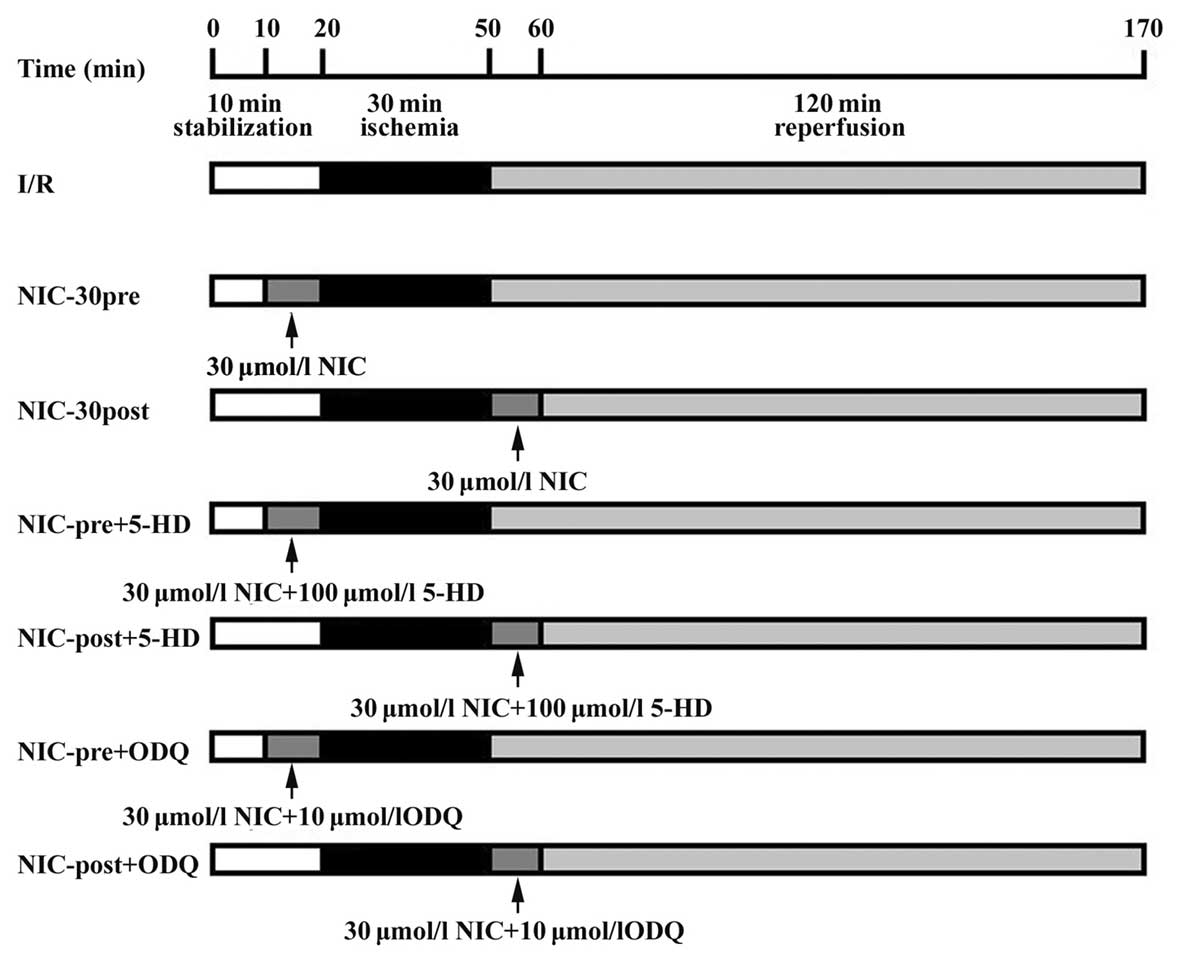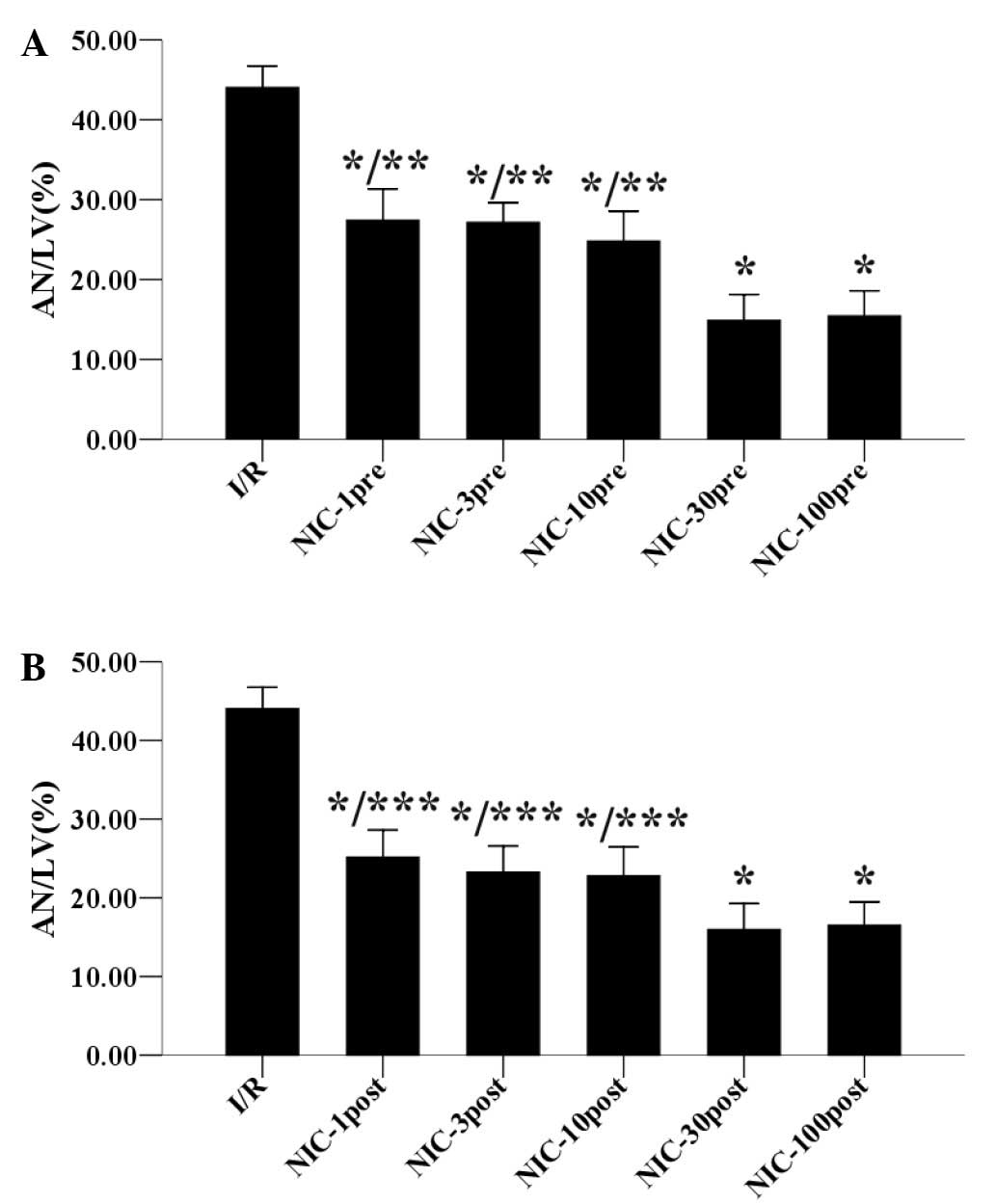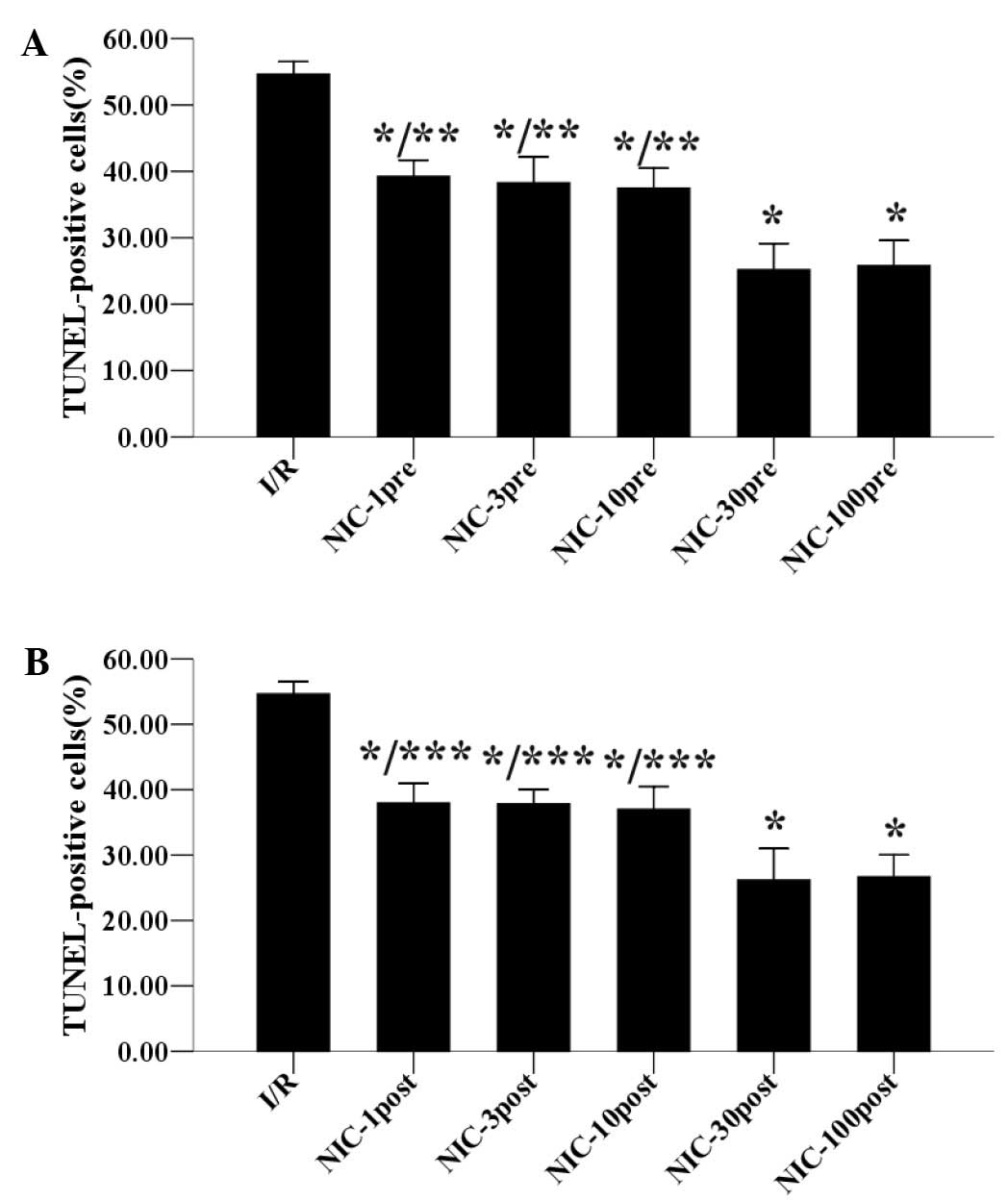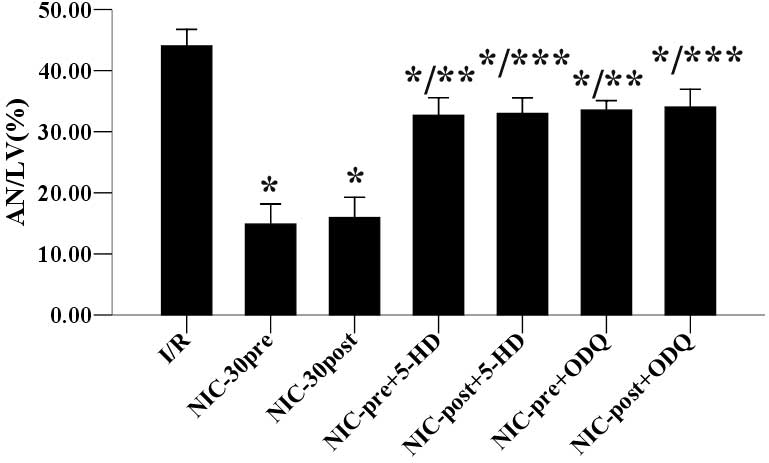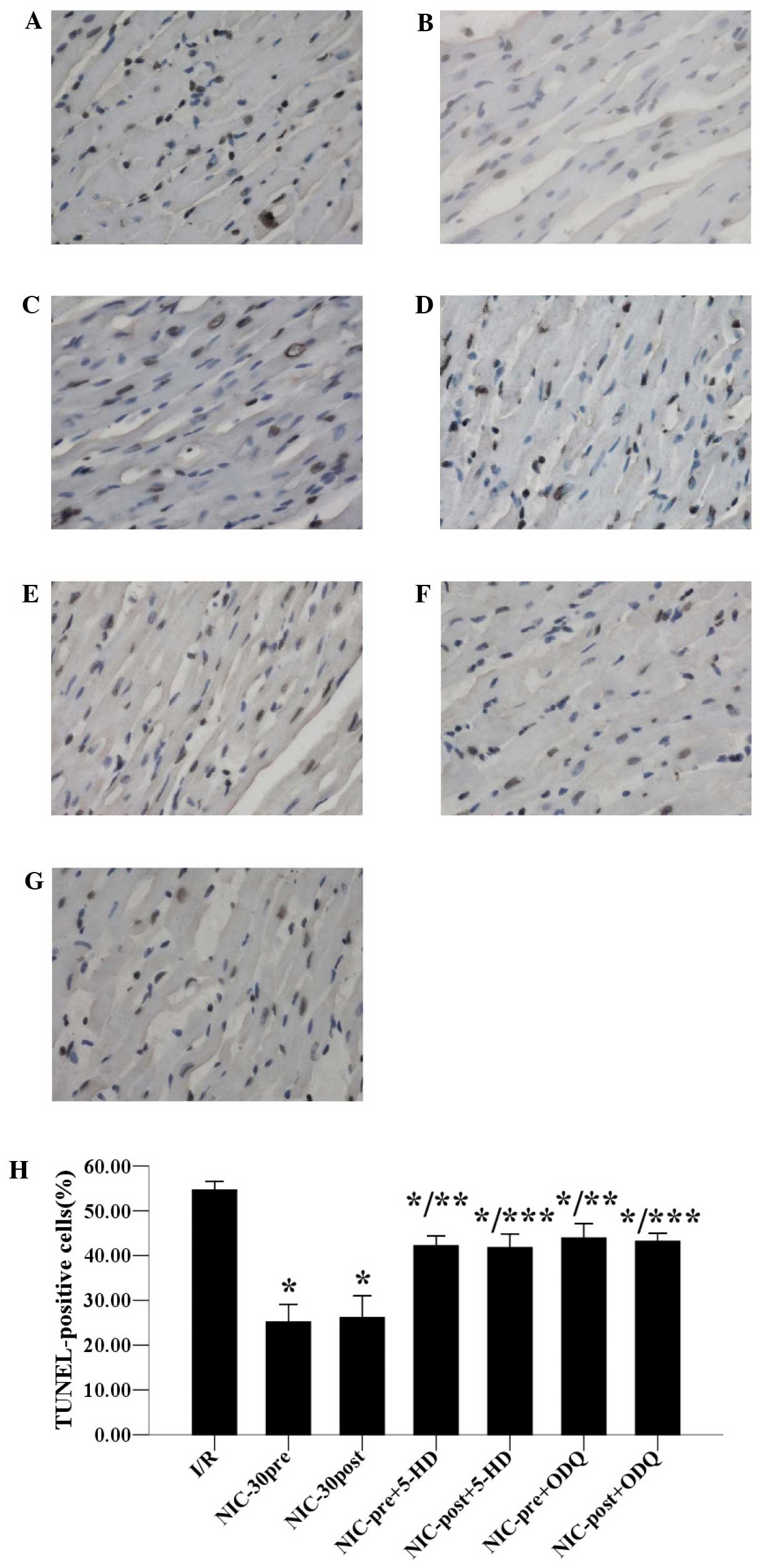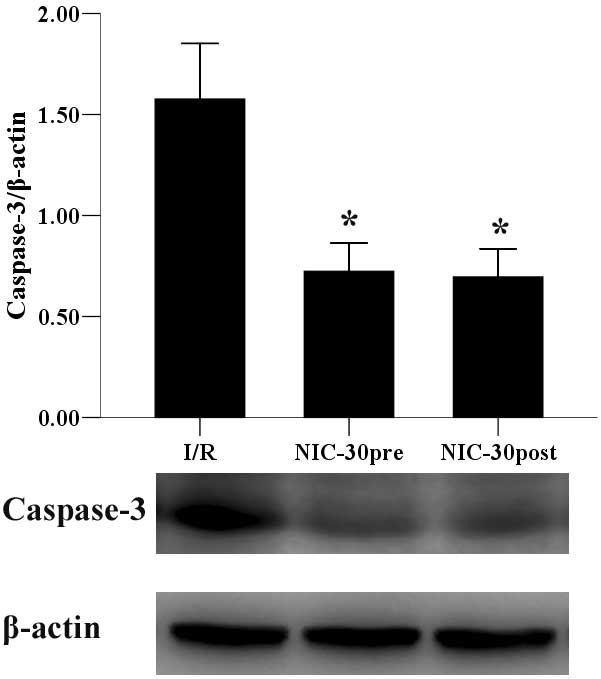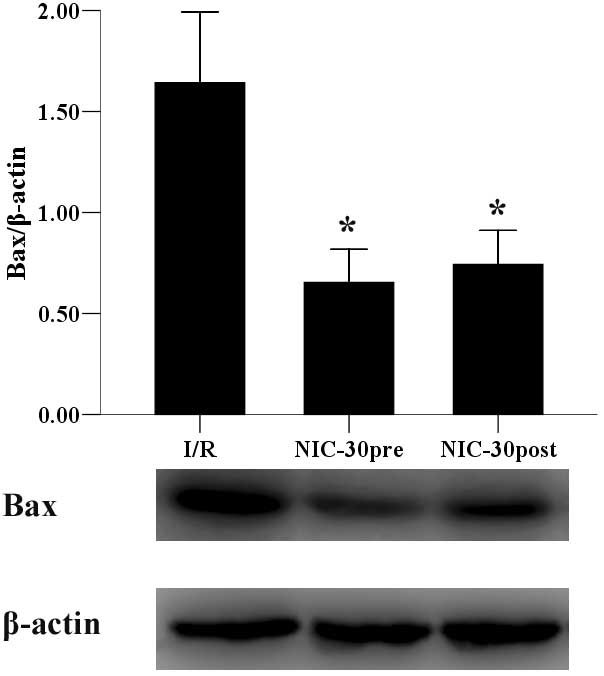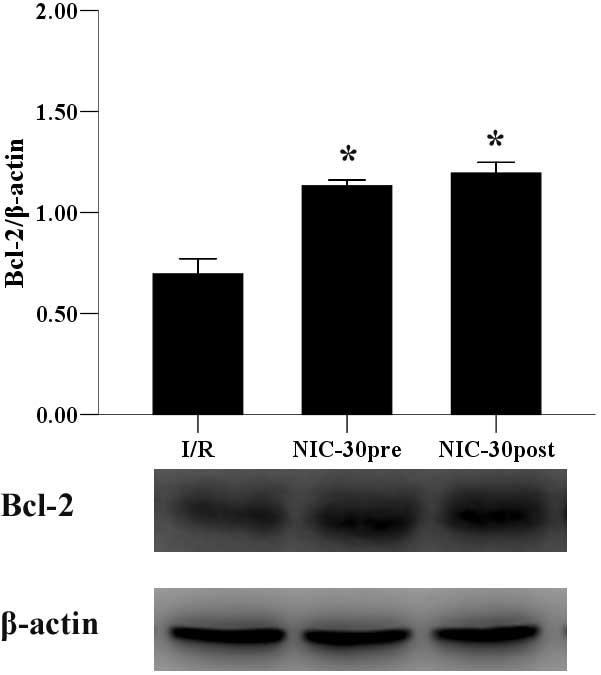|
1
|
Frank A, Bonney M, Bonney S, Weitzel L,
Koeppen M and Eckle T: Myocardial ischemia reperfusion injury: From
basic science to clinical bedside. Semin Cardiothorac Vasc Anesth.
16:123–132. 2012. View Article : Google Scholar : PubMed/NCBI
|
|
2
|
Hausenloy DJ and Yellon DM:
Preconditioning and postconditioning: Underlying mechanisms and
clinical application. Atherosclerosis. 204:334–341. 2009.
View Article : Google Scholar : PubMed/NCBI
|
|
3
|
Murry CE, Jennings RB and Reimer KA:
Preconditioning with ischemia: A delay of lethal cell injury in
ischemic myocardium. Circulation. 74:1124–1136. 1986. View Article : Google Scholar : PubMed/NCBI
|
|
4
|
Zhao ZQ, Corvera JS, Haulkos ME, Kerendi
F, Wang NP, Guyton RA and Vinten-Joansen J: Inhibition of
myocardial injury by ischemic postconditioning during reperfusion
comparision with ischemic preconditioning. Am J Physiol Heart Circ
Physiol. 285:579–588. 2003. View Article : Google Scholar
|
|
5
|
Gerczuk PZ and Kloner RA: Protecting the
heart from ischemia: An update on ischemic and pharmacologic
conditioning. Hosp Pract. 39:35–43. 2011. View Article : Google Scholar
|
|
6
|
Andreadou I, Iliodromitis EK, Koufaki M
and Kremastinos DT: Pharmacological pre- and post- conditioning
agents: Reperfusion-injury of the heart revisited. Mini Rev Med
Chem. 8:952–959. 2008. View Article : Google Scholar : PubMed/NCBI
|
|
7
|
Sack MN and Murphy E: The role of
comorbidities in cardioprotection. J Cardiovasc Pharmacol Ther.
16:267–272. 2011. View Article : Google Scholar : PubMed/NCBI
|
|
8
|
Balakumar P, Singh H, Singh M and
Anand-Srivastava MB: The impairment of preconditioning-mediated
cardioprotection in pathological conditions. Pharmacol Res.
60:18–23. 2009. View Article : Google Scholar : PubMed/NCBI
|
|
9
|
Ferdinandy P, Schulz R and Baxter GF:
Interaction of cardiovascular risk factors with myocardial
ischemia/reperfusion injury, preconditioning, and postconditioning.
Pharmacol Rev. 59:418–458. 2007. View Article : Google Scholar : PubMed/NCBI
|
|
10
|
Osipov RM, Bianchi C, Feng J, Clements RT,
Liu Y, Robich MP, Glazer HP, Sodha NR and Sellke FW: Effect of
hypercholesterolemia on myocardial necrosis and apoptosis in the
setting of ischemia-reperfusion. Circulation. 120(Suppl): S22–S30.
2009. View Article : Google Scholar : PubMed/NCBI
|
|
11
|
Wang TD, Chen WJ, Su SS, Lo SC, Lin WW and
Lee YT: Increased cardiomyocyte apoptosis following ischemia and
reperfusion in diet-induced hypercholesterolemia: Relation to Bcl-2
and Bax proteins and caspase-3 activity. Lipids. 37:385–394. 2002.
View Article : Google Scholar : PubMed/NCBI
|
|
12
|
Liu HR, Tao L, Gao E, Qu Y, Lau WB, Lopez
BL, Christopher TA, Koch W, Yue TL and Ma XL: Rosiglitazone
inhibits hypercholesterolaemia-induced myeloperoxidase
upregulation-a novel mechanism for the cardioprotective effects of
PPAR agonists. Cardiovasc Res. 81:344–352. 2009. View Article : Google Scholar : PubMed/NCBI
|
|
13
|
Onody A, Csonka C, Giricz Z and Ferdinandy
P: Hyperlipidemia induced by a cholesterol-rich diet leads to
enhanced peroxynitrite formation in rat hearts. Cardiovasc Res.
58:663–670. 2003. View Article : Google Scholar : PubMed/NCBI
|
|
14
|
Prasan AM, McCarron HC, Zhang Y and Jeremy
RW: Myocardial release of nitric oxide during ischaemia and
reperfusion: Effects of L-arginine and hypercholesterolaemia. Heart
Lung Circ. 16:274–281. 2007. View Article : Google Scholar : PubMed/NCBI
|
|
15
|
Genda S, Miura T, Miki T, Ichikawa Y and
Shimamoto K: K(ATP) channel opening is an endogenous mechanism of
protection against the no-reflow phenomenon but its function is
compromised by hypercholesterolemia. J Am Coll Cardiol.
40:1339–1346. 2002. View Article : Google Scholar : PubMed/NCBI
|
|
16
|
Görbe A, Varga ZV, Kupai K, Bencsik P,
Kocsis GF, Csont T, Boengler K, Schulz R and Ferdinandy P:
Cholesterol diet leads to attenuation of ischemic
preconditioning-induced cardiac protection: the role of connexin
43. Am J Physiol Heart Circ Physiol. 300:H1907–H1913. 2011.
View Article : Google Scholar : PubMed/NCBI
|
|
17
|
Wu N, Zhang X, Guan Y, Shu W, Jia P and
Jia D: Hypercholesterolemia abrogates the cardioprotection of
ischemic postconditioning in isolated rat heart: Roles of glycogen
synthase kinase-3β and the mitochondrial permeability transition
pore. Cell Biochem Biophys. 69:123–130. 2014. View Article : Google Scholar : PubMed/NCBI
|
|
18
|
Ma LL, Zhang FJ, Qian LB, Kong FJ, Sun JF,
Zhou C, Peng YN, Xu HJ, Wang WN, Wen CY, et al:
Hypercholesterolemia blocked sevoflurane-induced cardioprotection
against ischemia-reperfusion injury by alteration of the
MG53/RISK/GSK3β signaling. Int J Cardiol. 168:3671–3678. 2013.
View Article : Google Scholar : PubMed/NCBI
|
|
19
|
Horinaka S: Use of nicorandil in
cardiovascular disease and its optimization. Drugs. 71:1105–1119.
2011. View Article : Google Scholar : PubMed/NCBI
|
|
20
|
IONA Study Group: Effect of nicorandil on
coronary events in patients with stable angina: The Impact Of
Nicorandil in Angina (IONA) randomised trial. Lancet.
359:1269–1275. 2002. View Article : Google Scholar : PubMed/NCBI
|
|
21
|
Tsuchida A, Miura T, Tanno M, Sakamoto J,
Miki T, Kuno A, Matsumoto T, Ohnuma Y, Ichikawa Y and Shimamoto K:
Infarct size limitation by nicorandil: Roles of mitochondrial
K(ATP) channels, sarcolemmal K(ATP) channels, and protein kinase C.
J Am Coll Cardiol. 40:1523–1530. 2002. View Article : Google Scholar : PubMed/NCBI
|
|
22
|
Akao M, Teshima Y and Marbán E:
Antiapoptotic effect of nicorandil mediated by mitochondrial
atp-sensitive potassium channels in cultured cardiac myocytes. J Am
Coll Cardiol. 40:803–810. 2002. View Article : Google Scholar : PubMed/NCBI
|
|
23
|
Lu C, Minatoguchi S, Arai M, Wang N, Chen
XH, Bao N, Kawamura I, Yasuda S, Kobayashi H, Wu DJ, Takemura G and
Fujiwara H: Nicorandil improves post-ischemic myocardial
dysfunction in association with opening the mitochondrial K(ATP)
channels and decreasing hydroxyl radicals in isolated rat hearts.
Circ J. 70:1650–1654. 2006. View Article : Google Scholar : PubMed/NCBI
|
|
24
|
Nagata K, Obata K, Odashima M, Yamada A,
Somura F, Nishizawa T, Ichihara S, Izawa H, Iwase M, Hayakawa A,
Murohara T and Yokota M: Nicorandil inhibits oxidative
stress-induced apoptosis in cardiac myocytes through activation of
mitochondrial ATP-sensitive potassium channels and a nitrate-like
effect. J Mol Cell Cardiol. 35:1505–1512. 2003. View Article : Google Scholar : PubMed/NCBI
|
|
25
|
Nishikawa S, Tatsumi T, Shiraishi J,
Matsunaga S, Takeda M, Mano A, Kobara M, Keira N, Okigaki M,
Takahashi T and Matsubara H: Nicorandil regulates Bcl-2 family
proteins and protects cardiac myocytes against hypoxia-induced
apoptosis. J Mol Cell Cardiol. 40:510–519. 2006. View Article : Google Scholar : PubMed/NCBI
|
|
26
|
Wang A, Chen F, Xie Y, Guo Z and Yu Y:
Protective mechanism of nicorandil on rat myocardial
ischemia-reperfusion. J Cardiovasc Med (Hagerstown). 13:511–515.
2012. View Article : Google Scholar : PubMed/NCBI
|
|
27
|
Sato T, Sasaki N, O'Rourke B and Marbán E:
Nicorandil, a potent cardioprotective agent, acts by opening
mitochondrial ATP-dependent potassium channels. J Am Coll Cardiol.
35:514–518. 2000. View Article : Google Scholar : PubMed/NCBI
|
|
28
|
Costa AD, Pierre SV, Cohen MV, Downey JM
and Garlid KD: cGMP signalling in pre- and post-conditioning: The
role of mitochondria. Cardiovasc Res. 77:344–352. 2008. View Article : Google Scholar : PubMed/NCBI
|
|
29
|
Schwemmer M, Sommer O, Koeckerbauer R and
Bassenge E: Cardiovascular dysfunction in hypercholesterolemia
associated with enhanced formation of AT1-receptor and of
eicosanoids. JCardiovasc Pharmacol Ther. 5:59–68. 2000. View Article : Google Scholar
|
|
30
|
Giricz Z, Görbe A, Pipis J, Burley DS,
Ferdinandy P and Baxter GF: Hyperlipidaemia induced by a
high-cholesterol diet leads to the deterioration of
guanosine-3′,5′-cyclic monophosphate/protein kinase G-dependent
cardioprotection in rats. Br J Pharmacol. 158:1495–1502. 2009.
View Article : Google Scholar : PubMed/NCBI
|
|
31
|
Tang XL, Stein AB, Shirk G and Bolli R:
Hypercholesterolemia blunts NO donor-induced late preconditioning
against myocardial infarction in conscious rabbits. Basic Res
Cardiol. 99:395–403. 2004. View Article : Google Scholar : PubMed/NCBI
|
|
32
|
Sasaki N, Sato T, Ohler A, O'Rourke B and
Marbán E: Activation of mitochondrial ATP-dependent potassium
channels by nitric oxide. Circulation. 101:439–445. 2000.
View Article : Google Scholar : PubMed/NCBI
|
|
33
|
Harada N, Miura T, Dairaku Y, Kametani R,
Shibuya M, Wang R, Kawamura S and Matsuzaki M: NO donor-activated
PKC-δ plays a pivotal role in ischemic myocardial protection
through accelerated opening of mitochondrial K-ATP channels. J
Cardiovasc Pharmacol. 44:35–41. 2004. View Article : Google Scholar : PubMed/NCBI
|
|
34
|
Kuno A, Critz SD, Cohen MV and Downey JM:
Nicorandil opens mitochondrial K(ATP) channels not only directly
but also through a NO-PKG-dependent pathway. Basic Res Cardiol.
102:73–79. 2007. View Article : Google Scholar : PubMed/NCBI
|
|
35
|
Iliodromitis EK, Lazou A and Kremastinos
DT: Ischemic preconditioning: Protection against myocardial
necrosis and apoptosis. Vasc Health Risk Manag. 3:629–637.
2007.PubMed/NCBI
|
|
36
|
Wang H, Zuo X, Wang Q, Yu Y, Xie L, Wang
H, Wu H and Xie W: Nicorandil inhibits hypoxia-induced apoptosis in
human pulmonary artery endothelial cells through activation of
mitoKATP and regulation of eNOS and the NF-κB pathway. Int J Mol
Med. 32:187–194. 2013.PubMed/NCBI
|
|
37
|
Gustafsson AB and Gottlieb RA: Bcl-2
family members and apoptosis, taken to heart. Am J Physiol Cell
Physiol. 292:C45–C51. 2007. View Article : Google Scholar : PubMed/NCBI
|



